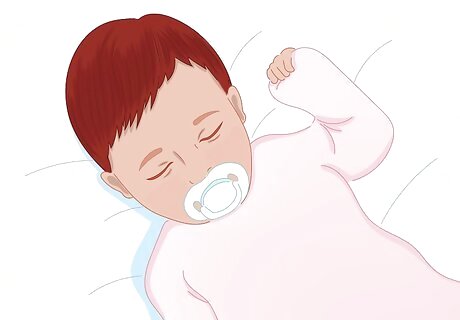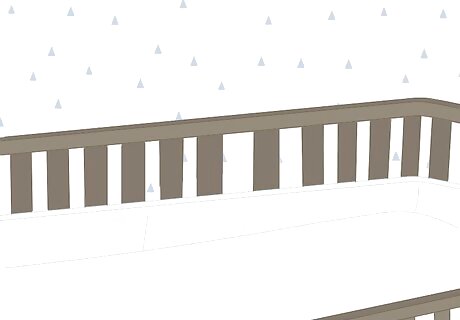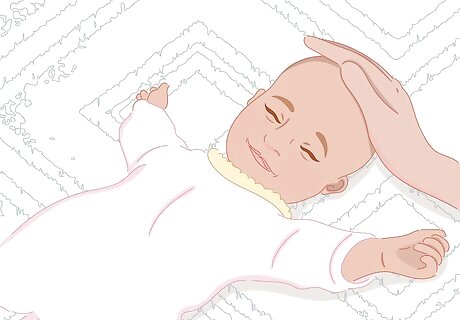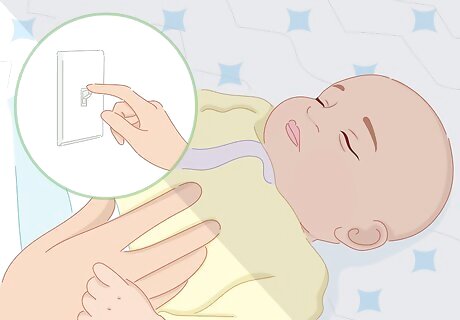
views
Swaddle your newborn.

Wrap your baby in a swaddling cloth or sleep sack to make them feel secure. Sometimes, newborns can twitch or jerk when they sleep, which actually makes them wake up! Prevent these disruptions and make your baby feel snug by swaddling them before you lay them back down. To swaddle, lay your baby on a blanket and tuck their arms along their sides before you securely wrap a blanket around them. You can swaddle your newborn until they're around 2 months old or they start to roll over.
Pat your baby's back.
Rub your baby's back while they lay in the crib to reassure them. It's a familiar situation—your baby is comfortable after you've checked on them, but they start to fuss the moment you lay them in the crib. Make the transition easier by rubbing their back for a minute after you place them in the crib. A soothing, familiar touch can make them feel secure so they fall asleep easier. This is also a great trick to try if you don't want to pick up your baby and walk with them. Sometimes, a few comforting pats on the back are all your baby needs to feel reassured.
Try a baby massage.

A gentle massage can help your baby relax and get ready for bed. If you have baby massage oil or sorbolene cream, add a few drops to your hands. For 10 to 15 minutes, use slow, long strokes and moderate pressure to massage her arms, legs, hands, feet, back, and tummy. To massage their lower body, massage the soles of your baby’s feet and do long strokes up the baby’s leg. For the upper body, start at the shoulders and stroke inwards towards the chest. Gently rub their face, including her forehead, the bridge of her nose, and her head.
Offer a pacifier.

Give your baby a pacifier to soothe them to sleep. Some babies feel comforted when they suck which is why they might start to drift off when they're nursing or taking a bottle. Instead of letting your baby fall asleep while they're eating, offer a pacifier once they're finished so they can keep sucking. It's totally safe to give your baby a pacifier—studies even show that they might reduce the risk of Sudden Infant Death Syndrome (SIDS). Don't leave a pacifier that's attached to a cord with a clip in your baby's crib since they could choke on the cord. If you're breastfeeding, wait until breastfeeding is established—about 3 or 4 weeks after birth—before you offer a pacifier. This can prevent nipple confusion, where your baby struggles to switch between breastfeeding and bottle-feeding or using the pacifier.
Read your baby a story.

The sound of your voice might help your baby drift off to sleep. Be sure to use a low, quiet, monotone voice that won’t startle or stimulate them. Every baby is different and responds to stimuli differently, and if your baby doesn’t relax during storytime, try other soothing methods, such as: Walking around with them in your arms or in a carrier Rocking them gently in a chair or in your arms Singing a song Playing quiet music
Block out any light.

Dimming the lights will signal to your baby’s brain that it’s time for bed. Turn off bedroom lights, lamps, nightlights, monitors and screens, and anything else that might create artificial light. Unnatural light can interfere with our circadian rhythms, which is our natural sleep-wake cycle. Consider dimming the lights during your pre-bed routine to reduce your baby’s exposure to light before it’s time to sleep. Keep the room dark all night. Nighttime exposure to artificial light can suppress the body’s production of melatonin, which is the hormone responsible for regulating the sleep-wake cycle.
Lay your baby in their own crib to sleep.

Put your baby down on their back and keep things out of their crib. Your baby might squirm or move around a little after you lay them down, but resist the urge to pick them up immediately. Give them a few minutes to settle in before you check on them again. This helps them learn to fall asleep on their own, in their own space. It's tempting to put blankets, stuffed animals, and pillows in the crib to make it comfy, but leave these out. Instead, just cover the mattress with a fitted sheet and lay your baby in the crib so they're on their back. This can reduce the risk of Sudden Infant Death Syndrome (SIDS).
Make your baby comfy if they're teething.

Soothe your baby and stick to their bedtime routine to help them sleep. Babies can start teething around 6 months old and it can be uncomfortable. Your baby may be fussier and clingy, which can make it hard to put them down. To make bedtime easier, snuggle your baby a lot, gently hold a cold cloth over their gums, or let them nurse more. Although it's tough, remember that teething is temporary and your baby will soon be back to their usual sleep habits. If your baby seems like they're in a lot of pain—crying, not eating well, pulling on their ears—ask your pediatrician if it's okay to give your baby infant acetaminophen or ibuprofen. They can tell you how much medication to give and how often to dose them.
Change your baby's diaper and feed them.

They may be fussing because they're uncomfortable and need something. Ideally, you'll change your baby and feed them before you put them to bed, but young babies do wake up with dirty diapers or hungry bellies. Always check if your baby needs food or a clean diaper if they're crying in the middle of the night. You may have been told to put cereal in your baby's last bottle because it supposedly keeps their belly full for longer. However, doctors found that it can actually make them more restless since they're more likely to have gas pain.
Give your baby a chance to settle on their own.

Wait a few minutes before you respond to your baby's fussing. If they don't go back down or they're really crying, go in to check on them. Keep the lights off or very dim when you check to see if they need a clean diaper or if they're hungry. Once you've seen that your baby is comfy and full, lay them back in the crib while they're drowsy. When you check on your baby at night, try not to engage them too much or they may become really alert. For example, instead of talking to them a lot or making lots of eye contact, hum a soothing song and gently rub their back or stroke their head. Feel your baby's diaper through their pajamas. If it's soiled or heavy with wetness, change it, but if it doesn't feel very wet, wait until the morning.
Follow a simple soothing nighttime routine.

Create a basic routine to help your baby relax before they sleep. For newborns, this might mean keeping the lights dim and rocking them while singing. If your baby is older, you could read a little story and swaddle them before putting them to bed. Try baby massage or playing soft music, too. Whatever you choose to include in your baby's bedtime routine, make sure it's calming so your baby unwinds. You'll probably find that you look forward to this peaceful time, too! Be consistent so your baby starts to expect soothing downtime before they sleep.
Watch for signs that your baby is sleepy.

Get your baby ready for bed when you see their sleepy cues. When your baby gives you signs that they're sleepy, you know they're in the sweet spot for falling asleep. If you wait, your baby might get overtired and cranky, which actually makes it harder for them to drift off! Some of the most common sleepy signs are: Rubbing their eyes Fussing and clinging Pulling at their ears Yawning Drooping eyelids Making sucking noises
Put your baby to bed while they're still drowsy.

Encourage them to fall asleep on their own so they learn to settle themselves. If you have a newborn, it's pretty easy to lay them down in their crib once they fall asleep in your arms. Once your baby gets a few months older, though, try to put them in the crib before they're totally asleep. This way, they learn to drift off without you holding or rocking them. This also makes it a lot easier for the baby to soothe itself and fall back asleep if they wake up in the middle of the night. Reassure your baby when you lay them down. Rest your hand on their stomach or head for a few seconds so they know you're nearby.
Wait until your baby is at least 4 months old to start sleep training.

Help your baby fall into a sleep routine by putting them down at set times. Sticking with consistent bedtime and nap times can help your baby associate sleep with certain times. Wait until your baby is at least 4 months old before you try a schedule since younger babies need to wake frequently to eat. Once your baby is around 4 months old, they should be able to sleep for a 5-hour stretch, so sleep training is possible.

















Comments
0 comment